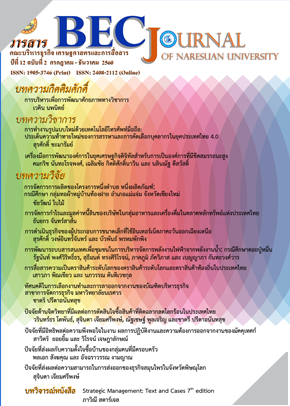การสื่อสารความเป็นตราสินค้าระดับโลกของตราสินค้าระดับโลกและตราสินค้าท้องถิ่นในประเทศไทย
Main Article Content
บทคัดย่อ
การวิจัยครั้งนี้มีวัตถุประสงค์เพื่อ 1. วิเคราะห์การสื่อสารความเป็นตราสินค้าระดับโลกของตราสินค้าระดับโลก และตราสินค้าท้องถิ่นโดยการใช้ระเบียบวิธีวิจัยเชิงคุณภาพ ด้วยการวิเคราะห์เนื้อหาสารในภาพยนตร์โฆษณาของตราสินค้าที่ใช้เป็นกรณีวิจัย และ 2. ศึกษาความสัมพันธ์ระหว่างการรับรู้ความเป็นตราสินค้าระดับโลก การรับรู้คุณภาพตราสินค้า และความตั้งใจซื้อของผู้บริโภค โดยการใช้ระเบียบวิธีวิจัยเชิงปริมาณ โดยการใช้แบบสอบถามเก็บข้อมูลจากกลุ่มตัวอย่างเพศชายและหญิง จำนวน 400 คน โดยประเภทสินค้าที่เลือกใช้เป็นสินค้าคงทน ได้แก่ โทรศัพท์มือถือ และสินค้าไม่คงทน ได้แก่ น้ำอัดลม ซึ่งสินค้าทั้ง 2 ประเภทมีตราสินค้าระดับโลกและตราสินค้าสินค้าท้องถิ่นวางจำหน่ายในประเทศไทย โดยประเภทโทรศัพท์มือถือได้แก่ ตราสินค้า ไอโฟน (ตราสินค้าระดับโลก) และไอ-โมบาย (ตราสินค้าท้องถิ่น) ส่วนในประเภทน้ำอัดลม ได้แก่ ตราสินค้า โคคา-โคลา (ตราสินค้าระดับโลก) และเอส (ตราสินค้าท้องถิ่น) ผลการวิจัยพบว่า ตราสินค้าทั้ง 4 ใช้วิธีสื่อสารความเป็นตราสินค้าระดับโลกผ่าน 3 ปัจจัย ได้แก่ 1. ปัจจัยด้านถ้อยคำ ด้วยการใช้ชื่อตราสินค้า และการใช้สโลแกนในการโฆษณา 2. ปัจจัยด้านสุนทรียะ ด้วยการใช้ผู้นำเสนอตราสินค้า และการใช้สัญลักษณ์ตราสินค้า และ 3. ปัจจัยด้านแก่นเรื่อง นอกจากนี้การรับรู้ความเป็นตราสินค้าระดับโลกมีความสัมพันธ์เชิงบวกกับการรับรู้คุณภาพตราสินค้า และความตั้งใจซื้อของผู้บริโภคอย่างมีนัยสำคัญทางสถิติ รวมทั้งการรับรู้คุณภาพตราสินค้ามีความสัมพันธ์เชิงบวกกับความตั้งใจซื้ออย่างมีนัยสำคัญทางสถิติเช่นเดียวกัน
Article Details
เอกสารอ้างอิง
2. Akram, A., Merunka, D. and Akram, M. S. (2011). Perceived brand globalness in emerging markets and the moderating role of consumer ethnocentrism. International Journal of Emerging Markets, 6(4), 291-303.
3. Alden, D. L., Steenkamp, J. E. and Batra, R. (1999). Brand positioning through advertising in Asia, North America, and Europe: The role of global consumer culture. Journal of Marketing, 63(January), 75-87.
4. Assael, H. (2004). Consumer behavior: A strategic approach. Boston: Houghton Mifflin Company.
5. Chang, C. (2008). The effectiveness of using a global look in an Asian market. Journal of Advertising Research, 48(2), 199-214.
6. Chen, T. Y., Yeh, T. L. and Jheng, W. S. (2013). Factor influencing brand association. African Journal of Business Management, 7(19), 1914-1926.
7. Dimofte, C. V., Johansson, J. K. and Ronkainen, I. A. (2008). Cognitive and affective reactions of U.S. consumers to global brands. Journal of International Marketing, 16(4), 113-135.
8. Holt, D. B., Quelch, J. A. and Taylor, E. L. (2004). How global brands compete. Harvard Business Review, 82(9), 68-75.
9. Interbrand. (2015). The 100 top brand: 2015 interbrand ranking. Retrieved February 25, 2016, from https://interbrand.com/best-brands/best-global-brands/2015/ranking/#?listFormat=ls
10. Jacobson, R. and Aaker, D. A. (1987). The strategic role of product quality. Journal of Marketing, 51(4), 31-44.
11. Jittakornkitjasil, P. (2009). International marketing communicaiton. MIS Journal of Naresuan University, 4(2), 22-34.
12. Keller, K. L. (2013). Strategic brand management: Building, measuring and managing brand equity. Boston: Pearson.
13. Kotler, P. and Armstrong, G. (2014). Principle of marketing (15th ed.). Harlow: Pearson.
14. Manageronline. (2015). “est” Rebranding-Restyle. Retrieved June 5, 2016, from https://www.manager.co.th/iBizChannel/ViewNews.aspx?NewsID=9570000114835
15. Meulenaer, S. D., Dens, N. and Pelsmacker, P. D. (2015). Which cues cause consumers to perceived brands as more global? A conjoint analysis. International Marketing Review, 32(6), 606-626.
16. Mooij, D. M. (2010). Global marketing and advertising: understanding cultural paradoxes. Los Angeles: Sage Publications.
17. Mooij, D. M and Hofstede, G. (2010). The Hofstede model application to global branding and advertising strategy and research. International Journal of Advertising, 29(1), 85-110.
18. Ophatwachirakul, N. (2010). Consumers' attitude towards brand, country of origin and brand equity of fashion product. Master thesis M.S., Chulalongkorn University, Bangkok.
19. Ozsomer, A. (2012). The interplay between global and local brands: A closer look at perceived brand globalness and local iconess. Journal of International Marketing, 20(2), 72-95.
20. Schiffman, L. G. and Kanuk, L. L. (2004). Consumer behavior (8th ed.). N.J.: Pearson/Prentice Hall.
21. Solomon, M. R. (2015). Consumer behavior: Buying having, and being (11th ed.). Boston: Pearson.
22. Steenkamp, J. E., Batra, R. and Alden, D. L. (2003). How perceived brand globalness creates brand value. Journal of International Business Studies, 34(1), 53-65.
23. Wiwattananukul, M. (2005). Intercultural communication. Bangkok: Chulalongkorn University Press.
24. Zeithaml, V. A. (1988). Consumer perception of price, quality and value: A mean-end model and synthesis of evidence. Journal of Marketing, 52(3), 2-22.


